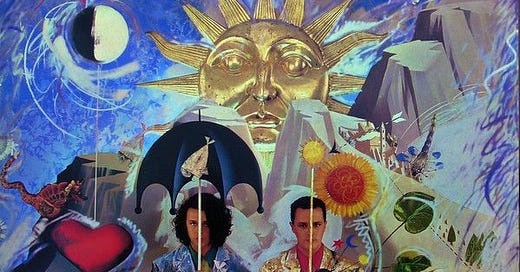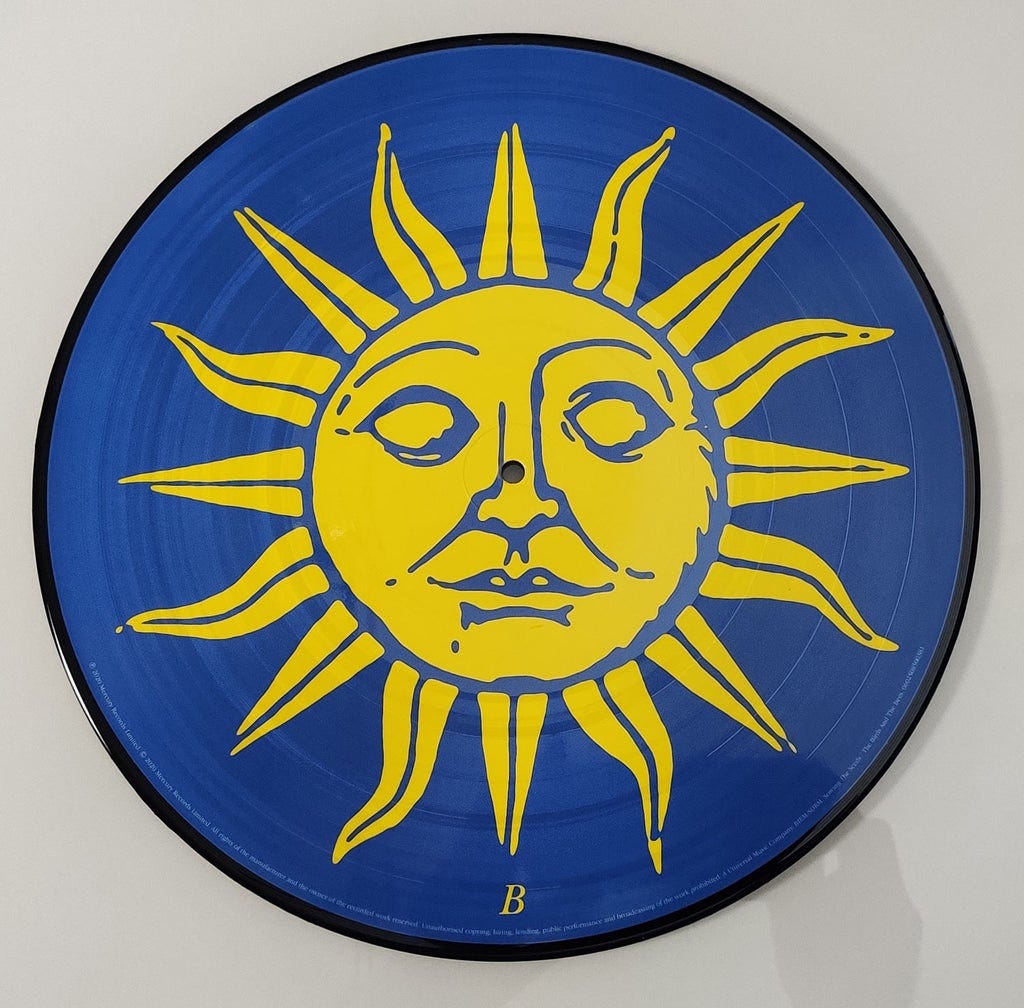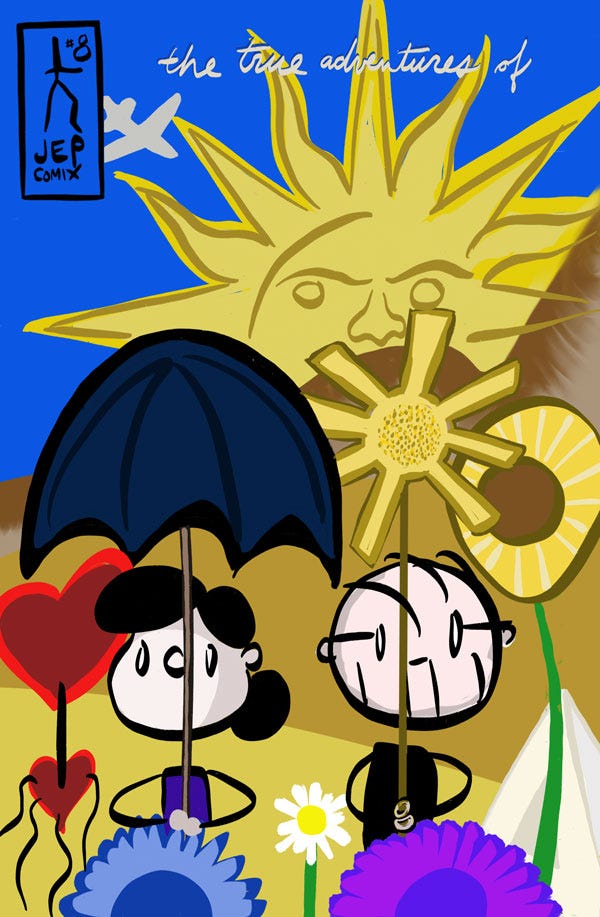There were two Tears for Fears. Not just in the fact of their being a duo, but also in the voices and song styles and in which of the two TFFs dominated at any particular time. I love one of them.
The initial one bugs me: the big sweaters and the vulnerable teenage depth of The Hurting – the cover, the songs about being sad, sung-over sequenced synths, and that strangely back-of-the-throat vocal, which is my deepest objection. That voice seems to have existed only in Britain and I have never had a name for it. There’s something choir-boy about it: is it a church voice? If you know what it’s called please tell me. Morrissey also had it, but he had the balance of a rocking band to sing atop and hilarious lyrics.
But there’s another Tears for Fears – a meaty, rocking side that first announced itself on Songs from the Big Chair, especially in the bridge of “Everybody Wants to Rule the World”:
It was a bolder voice, less stuck in its navel, and it was accompanied by heavy guitar. Much cooler. (I acknowledge, by the way, the total Rockist-Man vibe I’m projecting, praising “meatiness” when I don’t even eat meat. I know it sounds retrogressive and small minded, but take me in my context, please. I am really only talking about Tears for Fears here, through the lens of me. I do not find, for example, The Smiths excruciating – because I discovered them later, and never imbued them with my teenage angst. The Hurting-era TFF were in the perfectly wrong place and time for me, and I don’t enjoy listening to it very much.)
Tears for Fears 2
I like the second Tears for Fears a LOT. The Seeds of Love has been on my unwritten Favourite Records list for about 30 years. In school, my housemate and I often sat in the dark, smoking, drinking, and listening to The Seeds of Love. From the cover on in, I love the record.
We went and saw the concert at Maple Leaf Gardens, and it was a thrilling show – likely the last time I really enjoyed an arena concert. Shows at the Horseshoe would spoil me forever.
Since then, Tears for Fears have gone through some changes. Roland Orzabal kept the name and released two albums in the 90s: Elemental and Raoul and the Kings of Spain. I love some tracks on each.
Curt Smith released his own solo record, which was ignored. Then in the early aughts, they reunited for Everybody Loves a Happy Ending, basically an homage to an homage, a Seeds of Love revisit that sounded good but lacked depth.
Then they paused again for almost 20 years, and now they are returning, grey-haired, with The Tipping Point, out in a month. I’m glad for them, but like most past-the-era musical reunions, I’m not holding my breath.
Back to Seeds of Love
I still love The Seeds of Love, though, and can listen to it anytime. It was so clearly different from the first two records – no sequencers, for one, and a large band playing acoustic instruments. They’d famously acquired Oletta Adams, a singer/piano player who had blown their minds at a small venue on the road during the Big Chair tour – this story was the main refrain of the interviews they gave at the time.
The other story was not broadcast as loudly, and had to be gleaned. Orzabal had always been the better musician of the duo, but had been less bold, unable to sing the songs he wrote. So Smith was the lead singer of Tears for Fears 1, as well as the bass player and the face a lot of the time. On Songs from the Big Chair, Orzabal sings more often, but most songs are at least dual-voiced.
On The Seeds of Love, the dynamic is entirely altered. Smith gets a single (“Advice for the Young at Heart”), but it’s clearly Roland’s show. He’s the one who took an obsessive four years to realize the scope of the new songs – it is his vision – and as he would report in an interview, he “went from being someone who couldn’t sing the songs he wrote to being the only person who could sing the songs he wrote.”
The vocals on Seeds are, to me, astonishing – his range is formidable, and his use of his uncaged voice is exuberant and powerful. The vocals on the album-closing set of “Year of the Knife” and “Famous Last Words” are sometimes hard to believe.
Atop the atmosphere, these vocals are transcendent. If the duo’s dynamics had to be abandoned to allow that voice to sing out, the sacrifice is both clear and mandatory. It must happen. As Maria Bamford shouted while rolling around the stage making fart sounds: “If this is my song, how can I keep from singing?”
All told, the album is cohesive and only dated in places. The title track is of course as much a Beatles song as any Oasis track a couple years later, but it’s good. “Woman in Chains” stands among the more politically interesting late-80s/early-90s songs for me, and the shared vocals are lovely. But it is the non-single tracks that slay me: “Bad Man’s Song,” “Swords and Knives,” “Standing on the Corner of the Third World,” and the album closers I mentioned above. They take their time. They show off what the album was about.
By the Way
The eighth issue of my mini-comic was an homage to Seeds’ beautiful cover; the story inside is a recounting of a story starring a younger Marjan and myself versus a crazy landlord. It was the first one I printed in colour.
The Tipping Point
I am happy to see the duo reunited – the album The Tipping Point will be available on February 25, 2022. I look forward to hearing what they sound like this time. In the meantime, if you haven’t spent time with it, go back and put on your good headphones and listen to The Seeds of Love.*
* If you listen on Spotify or buy a recent CD, watch out. The album works as an album, and the “bonus” songs that get tacked on after “Famous Last Words” detract from the work. Try and listen to the actual album.
Thanks for reading. If you like it, please share it.
-jep








I remember being surprised by "Shout" and liking it a lot -- the chant-like feel really made me stop and listen (until it became really popular to do so and then I turned away -- LOL). "Everybody Wants to Rule the world" was one of my "trying to be cool" dance songs and then "Seeds" blew me away. There were echoes of the Beatles in the latter that really appealed to some nostalgia in me as I recall. Thanks for bringing them back to mind:)